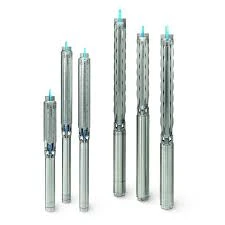Okt . 30, 2024 12:03 Back to list
deep well pump types
Understanding Deep Well Pump Types
Deep well pumps are essential components in various water extraction systems, particularly in agriculture, municipal water supply, and industrial applications. These pumps are designed to extract water from underground aquifers that are located at significant depths. The choice of pump type depends on various factors, including the depth of the well, the flow rate required, the power source available, and the specific application. This article explores the different types of deep well pumps and their applications.
Submersible Pumps
One of the most commonly used types of deep well pumps is the submersible pump. As the name suggests, these pumps are designed to operate while submerged in water. They consist of a motor and a pump mechanism that work together to draw water up to the surface. Submersible pumps are ideal for deep wells because they are efficient at lifting water from depths ranging from 100 to over 1000 feet. They are also advantageous because they do not require a priming mechanism, which is essential in other pump types. However, they do cost more to install and maintain than other pumps.
Jet Pumps
deep well pump types

Jet pumps are another popular choice for deep-water extraction. They operate based on the principle of creating a vacuum to lift water from deep wells. Jet pumps can be divided into two categories shallow well jet pumps and deep well jet pumps. Shallow well jet pumps can typically lift water from depths of up to 25 feet, while deep well jet pumps can reach depths of 100 feet or more. They are usually surface-mounted and are easier to access for maintenance. However, they are less efficient than submersible pumps when it comes to deeper applications.
Turbine Pumps
Turbine pumps are specifically designed for deep well applications where high flow rates are required. They consist of multiple impellers stacked vertically and can lift water from significant depths, making them suitable for agricultural irrigation and municipal water supply. These pumps are often mounted above ground and have long, vertical shafts that extend down into the well. Turbine pumps are robust and can operate effectively in harsh conditions, but their complexity can make installation and maintenance more challenging.
Conclusion
When selecting a deep well pump, it is crucial to consider the specific requirements of your application, including the depth of the well, the desired flow rate, and the environmental conditions. Submersible, jet, and turbine pumps each offer distinct advantages and drawbacks that make them suited for different scenarios. By understanding the various types of deep well pumps available and their respective functionalities, users can make informed decisions to ensure efficient and effective water extraction.
-
Water Pumps: Solutions for Every Need
NewsJul.30,2025
-
Submersible Well Pumps: Reliable Water Solutions
NewsJul.30,2025
-
Stainless Steel Water Pumps: Quality and Durability
NewsJul.30,2025
-
Powerful Water Pumps: Your Solution for Efficient Water Management
NewsJul.30,2025
-
Oil vs Water Filled Submersible Pumps: Which is Better?
NewsJul.30,2025
-
Deep Well Pumps: Power and Reliability
NewsJul.30,2025
-
 Water Pumps: Solutions for Every NeedWhen it comes to handling dirty water, the dirty water pump is a must-have.Detail
Water Pumps: Solutions for Every NeedWhen it comes to handling dirty water, the dirty water pump is a must-have.Detail -
 Submersible Well Pumps: Reliable Water SolutionsWhen it comes to ensuring a reliable water supply, submersible well pumps are a top choice.Detail
Submersible Well Pumps: Reliable Water SolutionsWhen it comes to ensuring a reliable water supply, submersible well pumps are a top choice.Detail -
 Stainless Steel Water Pumps: Quality and DurabilityWhen it comes to choosing a water pump, the stainless steel water pump price is a crucial factor.Detail
Stainless Steel Water Pumps: Quality and DurabilityWhen it comes to choosing a water pump, the stainless steel water pump price is a crucial factor.Detail
